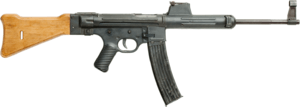StG 45(M)
| Sturmgewehr 45 | |
|---|---|
|
The Sturmgewehr 45 | |
| Type | Assault rifle |
| Place of origin |
|
| Service history | |
| In service | May 1945 |
| Used by | Germany |
| Wars | World War II |
| Production history | |
| Designer | Wilhelm Stähle |
| Designed | 1944 |
| Manufacturer | Mauser |
| Produced | 1945 |
| Number built | 30 |
| Specifications | |
| Weight | 4 kg (8.8 lb) (with empty magazine) |
| Length | 940 mm (37.0 in) |
| Barrel length | 419 mm (16.5 in) |
|
| |
| Cartridge | 7.92×33mm Kurz (Pistolenpatrone 7.9mm M43) |
| Action | Roller-delayed blowback |
| Rate of fire | 350–450 rounds/min |
| Muzzle velocity | 640 m/s (2,100 ft/s) |
| Effective firing range | 300 m |
| Maximum firing range | 800 m |
| Feed system | 10 or 30-round detachable box magazine |
| Sights | Rear: V-notch; front: hooded post |
The StG 45(M) (Sturmgewehr 45 literally "storm rifle" or "assault rifle 1945") sometimes referred to as the MP 45(M), was a prototype assault rifle developed by Mauser for the Wehrmacht at the end of World War II, using an innovative roller-delayed blowback operating system. It fired the 7.92×33mm Kurz (or "Pistolenpatrone 7.9mm") intermediate cartridge at a cyclic rate of around 450 rounds per minute.
Overview

The origin of this rifle can be traced back to the final years of World War II when Mauser engineers at the Light Weapon Development Group (Abteilung 37) at Oberndorf am Neckar designed the MKb Gerät 06 (Maschinenkarabiner Gerät 06 or "machine carbine instrument 06") prototype assault rifle chambered for the intermediate 7.92×33mm Kurz cartridge, first with the Gerät 06 model using a roller-locked short recoil mechanism originally adapted from the MG 42 machine gun, but with a fixed barrel and conventional gas-actuated piston rod.[1] It was realized that with careful attention to the mechanical ratios, the gas system could be omitted.[2] The resultant weapon, the Gerät 06H (the "H" suffix is an abbreviation for halbverriegelt or "half-locked") was assigned the designation StG 45(M) (Sturmgewehr 45(M)).
However, the design required that the bolt move while the bullet was still in the barrel and the spent case fully pressurized. Traditional chambers resulted in separated case heads during testing. The solution was to "flute" the chamber; longitudinal grooves were cut into the chamber to allow combustion gasses to float the neck and front of the case and assist in extraction. During the process, the case would be scorched in a manner which was characteristic for later Heckler & Koch blowback-operated weapons, which used the same principle.
The StG 45(M) was intended to replace the Sturmgewehr 44 assault rifle, because the latter was rather expensive and time-consuming to produce. Compared to the StG44's cost of 70 Reichsmarks, the StG45(M)'s calculated cost was 45 Reichsmarks. Parts for only 30 complete rifles were produced before the war ended.
While the StG45(M) was intended to use the same 30-round magazine as its predecessor, the rifle is commonly pictured with the 10-round magazine designed for the Volkssturmgewehr. The shorter magazine was used by Mauser engineers during testing, as its lower profile was easier to use when test-firing at the Mauser facility range.
Post–World War II developments

The German technicians involved in developing the Sturmgewehr 45 continued their research in France at CEAM. The StG45 mechanism was modified by Ludwig Vorgrimler and Theodor Löffler at the Mulhouse facility between 1946 and 1949. Three versions were made, chambered in .30 Carbine, 7.92×33mm Kurz as well as the 7.65×35mm cartridge developed by Cartoucherie de Valence and adopted in 1948. A 7.5×38mm cartridge using a partial aluminium bullet was abandoned in 1947. Löffler's design, designated the Carabine Mitrailleuse Modèle 1950, was retained for trials among 12 different prototypes designed by CEAM, MAC, and MAS. Vorgrimler later went to work at CETME in Spain and developed the line of CETME automatic rifles.
Germany eventually purchased the license for the CETME design and manufactured the Heckler & Koch G3 as well as an entire line of weapons built on the same system, one of the most famous being the MP5.
A few other post–World War II weapons used the roller-delayed locking system, such as the SIG SG 510.
See also
References
External links
- Do You Know Your HK's Parents? by Ian McCollum
- Last Ditch Innovation: The Development of the Gerat 06 and Gerat 06H Rifles (video)
- StG45 at an IPSC 3-Gun Match (Video)
